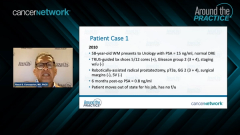
Imaging Modalities for Evaluating Biochemical Recurrence in Prostate Cancer
An expert panel reacts to polling data on choice of imaging modalities for patients with prostate patients after definitive therapy and share their insights about best practices.
Episodes in this series

Raoul S. Concepcion, MD, FACS:If that patient presented today, and came to you as a second opinion, is bone scan and CT your choice still? Describe to me what other imaging modalities you might consider.
Munir Ghesani, MD: Thank you again for inviting me. It’s an honor and privilege to be on this panel. With regard to the current day and age, the answer to this also will depend on which geographic region you are in, because there are certain agents that are approved that are widely available, and there are others that have more limited availability, because of either half-life limitation of the agent, or the way the FDA approval has been structured. Let me expand on that. Going back first to your question, the bone scan and the CT scan would not be the standard of care now, because there are other options. These options include the PET [positron emission tomography scan]/CT agents or PET MRI, if there are certain geographic regions that have it available. The most widely available agent right now is the fluciclovine, which is a fluorine-18–based agent. It has a half-life of close to 2 hours. Therefore, for most commercial radiopharmacies around the country, there is a network sufficient that if there is any PET scanner in any geographic region in the country, they will have access to fluciclovine.
There are a few other agents, such as C-11 choline, which is available and approved. However, because of its half-life, the availability is going to be limited very close to a cyclotron, or most of the times, the sites that have a cyclotron can access that agent. As of November, or December of 2020, the very first PSMA [prostate-specific membrane antigen] agent was approved by the FDA, and that is the gallium PSMA agent. That has the approval primarily through UCLA [the University of California, Los Angeles] and UCSF [the University of California, San Francisco]. However, UCLA and UCSF have been kind enough not to hold onto the IND [investigational new drug] proprietarily, so there is access if there is a cross reference to the IND for the sites that are doing the studies and have approached the FDA to cross reference it. Finally, there are many other PSMA agents that are available through the clinical trials. So, if any one of the sites is participating in these trials, there is access to those PSMA agents that are still not approved by the FDA. However, we’ll discuss them later during our subsequent discussions on the imaging side, but that is also an available access through the clinical trials.
Raoul S. Concepcion, MD, FACS: Perfect. We’re going to go to a second polling question. I think the audience has already seen this. If this patient presented today, and assuming you would re-stage the patient, what imaging modality would you choose? Dr Ghesani gave a nice and brief summary on this. Would the audience continue to do their first restaging technetium bone scan and CT of the abdomen and pelvis, with and without IV [intravenous] contrast, whole body MRI, fluciclovine, gallium PSMA PET, C-11 choline, or other? This will give us [an idea about], as Dr Ghesani said, what’s available out there in your various marketplaces, because it’s not equal around the country. I think your point is very well taken. I don’t think a lot of people realize that when the gallium PSMA scan was approved, that it was specifically for UCLA and UCSF.
Looking at the polling question, we’ve got about 23%, a quarter, would still do bone scan, CT. Nobody would do a whole-body MRI. Close to 50% is going to use fluciclovine. Finally, 30% are going to do gallium PSA [prostate-specific antigen]. Judd, what do you have over there at Duke [Cancer Center]?
Judd W. Moul, MD: I really appreciated Munir’s comments. I think from an academic standpoint, he’s right on target. The problem is, at least in the trenches where I’m at in North Carolina, a lot of times insurance carriers will not cover the Axumin [fluciclovine] scan until you’ve done the bone scan and CT. Often, I don’t know if Brian’s running into that in Chicago, but you order it, and then I’ll get a call to do a peer-to-peer [discussion], which is never really a peer-to-peer, it’s someone on the other end who doesn’t really know what they’re talking about, but that’s another story. They will say, “Have you done a bone scan and a CT? We need to see a negative bone scan and a CT before we’ll pay for the Axumin.” I don’t know, that needs to change, because it’s a waste of money. Nevertheless, that’s what we’re facing in early 2021.
Raoul S. Concepcion, MD, FACS: Brian?
Brian Helfand, MD, PhD: I think that most clinicians, and certainly insurance companies, don’t necessarily recognize that the sensitivity of a bone and CT scan is very limited. Historically, as you said, and back even in the early to mid-2000s, and even today, we order these tests. However, half of it’s out of necessity to meet insurance standards, but the sensitivity, at levels less than 10, and less than 20 [ng/mL] certainly, are poor. Moreover, it’s been studied and suggested that up to 90% of scans at that level will be negative, but nonetheless, that’s our gold standard for what we compare against. When those studies came out, it was because choline was being FDA approved at the time, and you needed a PSA level recurrence of about 2 [ng/mL], at minimum.
Therefore, a lot of these insurance companies adopted a level that said, “Hey, not only would you have to get a CT and a bone scan first, but I want to see your patients’ PSA level at about 2 [ng/mL] before we’re going to approve that.” There is some variability there, and certainly Medicare is better, but it’s frustrating. The point here is that if we can locate that disease and we can treat this at volumes when the tumor is still small, certainly, patients are going to have better outcomes.
Post-surgery, there have been many trials that say if you treat patients at an early time, when their PSA values are between 0.2 and 0.5 [ng/mL], they’re going to do better than if we wait until those values are higher. We typically want to get these types of what we call next-generation imaging scans, or these PET/CT scans, whether it’s fluciclovine or a PSMA scans, at earlier levels, which we believe help patients better. I agree with Judd that often, I must go through those hoops, although it’s a futile exercise and extra radiation exposure to the patient. From there, the patients become frustrated because I don’t hide my angst for these hoops. But I think it’s the way that we get the right scans these days.
Transcript edited for clarity.
Newsletter
Stay up to date on recent advances in the multidisciplinary approach to cancer.








































































































